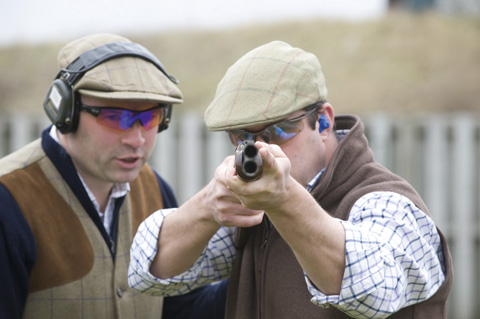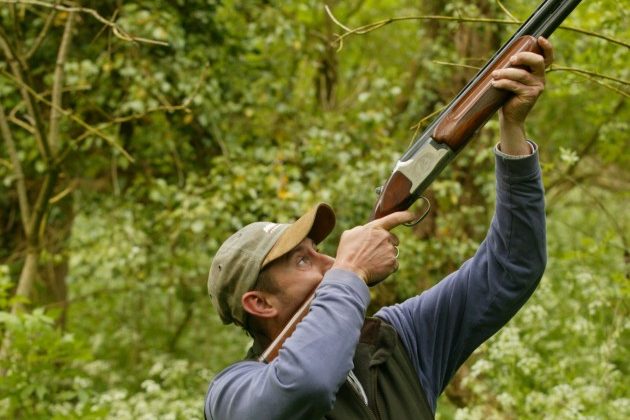How I learned to be a better Shot
I shoot game regularly and I am reasonably confident in my ability to consistently bring down normal driven pheasants. But there are some days, or even just some drives, when I am left scratching my head. More often than not I struggle on longer crossers but sometimes overhead driven shooting lets me down too. So I decided to do something about it ...

Like skiing, tennis or golf, shooting is a sport where one-to-one instruction is a mixture of technical input and psychological assistance, so it is important to find the right person for you. There are plenty of good shooting schools all over the country but I was to benefit from the wisdom of Adam Calvert.
Adam regularly spends more than 90 days in the shooting field each season with clients. So he has a vast amount of experience in how game shooters think and the common mistakes they make. I went to him and said: “Adam, I want to be a better shot. What am I doing wrong and how can I correct it?”
Gun mount issues
I have never had my gun fitted, so this was the obvious starting point. Having checked that I am still right-eye dominant (this can change over time so it’s worth checking) Adam asked me to dry-mount the gun so he could make an initial assessment.


It’s apparent from these pictures that the grip on the author’s gun is not right for his hand. In the gun-down position the trigger finger extends beyond the front of the trigger guard. So to compensate, the right hand moves down the grip during the gun mount, causing unnecessary movement and distraction. This is a clear example of how good gun fit can help you become a better shot.
Immediately he looked concerned. The butt of the stock was not fitting into the pocket of my shoulder as it should and my right eye was not directly aligned over the rib of the barrels. Due to a lack of cast (bend in the stock) I had developed a way of mounting the gun to deal with this, but it was far from ideal.
In fact, Adam immediately asked me to change my stance so that my feet face further forward. This means the whole torso is more open and it is easier to get the butt into the shoulder pocket because it is much more accessible. He also spotted that I was mounting into the shoulder first and cheek second – another mistake!
So, within two minutes and without stepping outside, I was practising a different stance and gun mount, with the end result being that my right eye was now looking down the same line as the barrels.
How important is gun fit?
So, my gun does not have enough cast for me and this need will vary in accordance with shape, size and eye dominance. But Adam also spotted that the grip is not ideal for my hand shape and size. This is not something I had thought about before, but as soon as it was pointed out, it became obvious that I was sub-consciously making allowances for this as I moved into the gun mount. Unless you have had the gun made to measure, it is highly unlikely that everything will fit properly. This doesn’t mean you can’t shoot with it, but if the stock length and cast, grip and comb height are all adjusted to suit you then you will inevitably become a better shot.
Driven clays
Having assessed my gun mount indoors, Adam’s next step was to see what happens when faced with the real thing. When faced with the lowest of driven clays, I suddenly found I was concentrating so hard on my stance and gun mount that the target was not so straightforward. I had enough composure to break a few but I don’t think I impressed my instructor, who asked me to work on a better body position, with my hips and bum further back and head further forward.

During gun mount the stock should come into the cheek before the butt goes into the shoulder.
Moving to a more challenging stand – with a small tower throwing driven birds to the left, overhead and to the right – started to show up a few more problems, particularly with the clay to the left.
I asked about how early the shot should be taken. Adam’s response was that as long as it is a successful shot then it is up to the individual how early or late to take the bird. However, he did explain the following:
- Waiting for the pheasant to commit to its line of flight is important.
- If you mount on to a pheasant too early and then it starts to curl off, it is hard to follow the line because you have set yourself up for the straight driven shot.
- This is something that can really only be learned by observing birds in flight on shoot day.
- Eventually it becomes easier to judge when the bird has committed and when it’s time to engage.

Have you ever taken your shotgun to a pattern plate? It’s a very easy way of finding out how straight you are shooting.
The pattern plate
A pattern plate is a really useful demonstration of exactly where your shot is going and how big the spread is at different ranges. My first two shots clearly indicated I was shooting slightly to the left. Once you have had a couple of shots it is human nature to over-compensate for any waywardness and this is exactly what I did. But generally the shot seemed to be hitting the right area, which was reassuring.

Adam Calvert shows the spread of the shot – wider than you might think!
Higher and longer
After the pattern plate we moved to a higher tower. Here things finally started to click into place and I began to receive more positive feedback from behind my right shoulder. Everybody sees lead or forward allowance in different ways and for me it’s in the smallest measurements.
I had one drive last season where I was on the left-hand end of the line and I walked up with the beating line as they went through the wood to my left. On this drive I missed a succession of birds on the left as they flew back over the wood. At the time I wasn’t sure what the problem was but on this tower everything became crystal clear. A series of similar targets kept flying unscathed after my shot. Adam knew exactly what the problem was but wanted me to work it out for myself. Eventually I realised that I had to give the bird quite a lot more lead than I thought.
Gun mount and gun fit – going back to basics
Close decoying pigeons often look like the easiest shot, but too many misses can be the start to a memorable…
Three questions about eye dominance
I have to close my left eye because of eye dominance, so sometimes I lose sight of high driven birds…
Our beginner’s guide to shooting – what you need to know
Beginner’s guide to shooting: Here we have the answers to some of the questions you have asked about starting shooting.
What did I learn?
At the end of this session, Adam asked me to focus on just two things.
The first is practising my gun mount. I need to take an unloaded gun and practice the gun mount repetitively, until the gun is coming perfectly into my cheek without thinking about it, and my right eye is aligned over the rib.
The second thing he asked me to work on is being more confident with lead. I need to swing through the bird more swiftly after mounting the gun. We also talked about taking a few practice swings on the peg before a drive starts.
Self-consciousness usually prevents me from doing this but now I can really see the value. A couple of swings to the left, straight overhead and to the right will really help establish where the birds might come from and what it will look like when they do.
Practice makes for a better Shot
There is a tendency in the shooting world to steer well away from one-to-one instruction because we believe we can sort it out ourselves, and it’s nothing that won’t come right with a bit of practice. Also, we don’t want to face up to any long-established bad habits because correcting them might be time consuming and take real effort. But think of all the famous top shots in this country. Don’t believe for one second that they don’t practice. So go and see an instructor. You will not regret it because it will make you a better shot.











